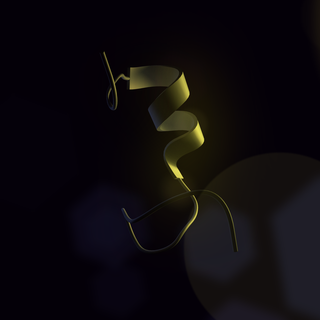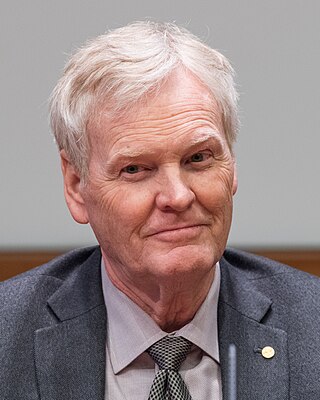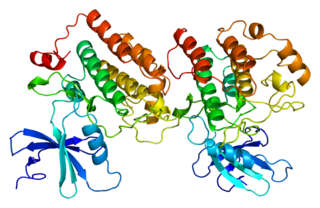Related Research Articles
A circadian clock, or circadian oscillator, is a biochemical oscillator that cycles with a stable phase and is synchronized with solar time.
The Casein kinase 1 family of protein kinases are serine/threonine-selective enzymes that function as regulators of signal transduction pathways in most eukaryotic cell types. CK1 isoforms are involved in Wnt signaling, circadian rhythms, nucleo-cytoplasmic shuttling of transcription factors, DNA repair, and DNA transcription.

CLOCK is a gene encoding a basic helix-loop-helix-PAS transcription factor that is known to affect both the persistence and period of circadian rhythms.
Timeless (tim) is a gene in multiple species but is most notable for its role in Drosophila for encoding TIM, an essential protein that regulates circadian rhythm. Timeless mRNA and protein oscillate rhythmically with time as part of a transcription-translation negative feedback loop involving the period (per) gene and its protein.
Period (per) is a gene located on the X chromosome of Drosophila melanogaster. Oscillations in levels of both per transcript and its corresponding protein PER have a period of approximately 24 hours and together play a central role in the molecular mechanism of the Drosophila biological clock driving circadian rhythms in eclosion and locomotor activity. Mutations in the per gene can shorten (perS), lengthen (perL), and even abolish (per0) the period of the circadian rhythm.

PER2 is a protein in mammals encoded by the PER2 gene. PER2 is noted for its major role in circadian rhythms.

The PER1 gene encodes the period circadian protein homolog 1 protein in humans.
In molecular biology, an oscillating gene is a gene that is expressed in a rhythmic pattern or in periodic cycles. Oscillating genes are usually circadian and can be identified by periodic changes in the state of an organism. Circadian rhythms, controlled by oscillating genes, have a period of approximately 24 hours. For example, plant leaves opening and closing at different times of the day or the sleep-wake schedule of animals can all include circadian rhythms. Other periods are also possible, such as 29.5 days resulting from circalunar rhythms or 12.4 hours resulting from circatidal rhythms. Oscillating genes include both core clock component genes and output genes. A core clock component gene is a gene necessary for to the pacemaker. However, an output oscillating gene, such as the AVP gene, is rhythmic but not necessary to the pacemaker.
Joseph S. Takahashi is a Japanese American neurobiologist and geneticist. Takahashi is a professor at University of Texas Southwestern Medical Center as well as an investigator at the Howard Hughes Medical Institute. Takahashi's research group discovered the genetic basis for the mammalian circadian clock in 1994 and identified the Clock gene in 1997. Takahashi was elected to the National Academy of Sciences in 2003.

Cycle (cyc) is a gene in Drosophila melanogaster that encodes the CYCLE protein (CYC). The Cycle gene (cyc) is expressed in a variety of cell types in a circadian manner. It is involved in controlling both the sleep-wake cycle and circadian regulation of gene expression by promoting transcription in a negative feedback mechanism. The cyc gene is located on the left arm of chromosome 3 and codes for a transcription factor containing a basic helix-loop-helix (bHLH) domain and a PAS domain. The 2.17 kb cyc gene is divided into 5 coding exons totaling 1,625 base pairs which code for 413 aminos acid residues. Currently 19 alleles are known for cyc. Orthologs performing the same function in other species include ARNTL and ARNTL2.
Doubletime (dbt) also known as discs overgrown (dco) is a gene that encodes the double-time protein (DBT) in Drosophila melanogaster. The double-time protein is a kinase that phosphorylates PER protein that regulates the molecularly-driven, biological clock controlling circadian rhythm. The mammalian homolog of doubletime is casein kinase I epsilon. Different mutations in the dbt gene have been shown to cause lengthening, shortening, or complete loss in period of locomotor activity in flies. Drosophila and certain vertebrate Casein Kinase Id shows circadian function that has been evolutionary conserved over long time spans.

Michael Morris Rosbash is an American geneticist and chronobiologist. Rosbash is a professor and researcher at Brandeis University and investigator at the Howard Hughes Medical Institute. Rosbash's research group cloned the Drosophila period gene in 1984 and proposed the Transcription Translation Negative Feedback Loop for circadian clocks in 1990. In 1998, they discovered the cycle gene, clock gene, and cryptochrome photoreceptor in Drosophila through the use of forward genetics, by first identifying the phenotype of a mutant and then determining the genetics behind the mutation. Rosbash was elected to the National Academy of Sciences in 2003. Along with Michael W. Young and Jeffrey C. Hall, he was awarded the 2017 Nobel Prize in Physiology or Medicine "for their discoveries of molecular mechanisms controlling the circadian rhythm".

Michael Warren Young is an American biologist and geneticist. He has dedicated over three decades to research studying genetically controlled patterns of sleep and wakefulness within Drosophila melanogaster.

Casein kinase I isoform epsilon or CK1ε, is an enzyme that is encoded by the CSNK1E gene in humans. It is the mammalian homolog of doubletime. CK1ε is a serine/threonine protein kinase and is very highly conserved; therefore, this kinase is very similar to other members of the casein kinase 1 family, of which there are seven mammalian isoforms. CK1ε is most similar to CK1δ in structure and function as the two enzymes maintain a high sequence similarity on their regulatory C-terminal and catalytic domains. This gene is a major component of the mammalian oscillator which controls cellular circadian rhythms. CK1ε has also been implicated in modulating various human health issues such as cancer, neurodegenerative diseases, and diabetes.
Amita Sehgal is a molecular biologist and chronobiologist in the Department of Neuroscience at the Perelman School of Medicine at the University of Pennsylvania. Sehgal was involved in the discovery of Drosophila TIM and many other important components of the Drosophila clock mechanism. Sehgal also played a pivotal role in the development of Drosophila as a model for the study of sleep. Her research continues to be focused on understanding the genetic basis of sleep and also how circadian systems relate to other aspects of physiology.
Paul Hardin is a prominent scientist in the field of chronobiology and a pioneering researcher in the understanding of circadian clocks in flies and mammals. Hardin currently serves as a distinguished professor in the biology department at Texas A&M University. He is best known for his discovery of circadian oscillations in the mRNA of the clock gene Period (per), the importance of the E-Box in per activation, the interlocked feedback loops that control rhythms in activator gene transcription, and the circadian regulation of olfaction in Drosophila melanogaster. Born in a suburb of Chicago, Matteson, Illinois, Hardin currently resides in College Station, Texas, with his wife and three children.

Drosophila circadian rhythm is a daily 24-hour cycle of rest and activity in the fruit flies of the genus Drosophila. The biological process was discovered and is best understood in the species Drosophila melanogaster. Other than normal sleep-wake activity, D. melanogaster has two unique daily behaviours, namely regular vibration during the process of hatching from the pupa, and during mating. Locomotor activity is maximum at dawn and dusk, while eclosion is at dawn.
Transcription-translation feedback loop (TTFL) is a cellular model for explaining circadian rhythms in behavior and physiology. Widely conserved across species, the TTFL is auto-regulatory, in which transcription of clock genes is regulated by their own protein products.
dClock (clk) is a gene located on the 3L chromosome of Drosophila melanogaster. Mapping and cloning of the gene indicates that it is the Drosophila homolog of the mouse gene CLOCK (mClock). The Jrk mutation disrupts the transcription cycling of per and tim and manifests dominant effects.
Ravi Allada is an Indian-American chronobiologist studying the circadian and homeostatic regulation of sleep primarily in the fruit fly Drosophila. He is the Edward C. Stuntz Distinguished Professor of Neuroscience and Chair of the Department of Neurobiology at Northwestern University. Working with Michael Rosbash, he positionally cloned the Drosophila Clock gene. In his laboratory at Northwestern, he discovered a conserved mechanism for circadian control of sleep-wake cycle, as well as circuit mechanisms that manage levels of sleep.
References
- ↑ Price, Jeffrey L. E-mail interview. 6 April 2017.
- ↑ "Faculty Detail: Jeffrey Price, Associate Professor, MBB | Ph.D. Doctoral Faculty." School of Biological Sciences: University of Missouri-Kansas City. Curators of the University of Missouri, n.d. Web. 11 Apr. 2017. Archived 2015-03-16 at the Wayback Machine
- ↑ Dunlap, JC (1999). "Molecular bases for circadian clocks". Cell. 96 (2): 271–290. doi: 10.1016/S0092-8674(00)80566-8 . PMID 9988221.
- ↑ Sehgal A, Price JL, Man B, Young MW (1994). "Loss of circadian behavioral rhythms and per RNA oscillations in the Drosophila mutant timeless". Science. 263 (5153): 1603–06. Bibcode:1994Sci...263.1603S. doi:10.1126/science.8128246. PMID 8128246.
- ↑ Vosshal LB, Price JL, Sehgal A, Saez L, Young MW (1994). "Block in nuclear localization of period protein by a second clock mutation, timeless". Science. 263 (5153): 1606–09. Bibcode:1994Sci...263.1606V. doi:10.1126/science.8128247. PMID 8128247.
- ↑ Rothenfluh A, Abodeely M, Price JL, Young MW (2000). "Isolation and analysis of six timeless alleles which cause short- or long-period circadian rhythms in Drosophila". Genetics. 156 (2): 665–75. doi:10.1093/genetics/156.2.665. PMC 1461293 . PMID 11014814.
- ↑ Price JL, Blau J, Rothenfluh A, Abodeely M, Kloss B, Young MW (1998). "double-time is a novel Drosophila clock gene that regulates PERIOD protein accumulation". Cell. 94 (1): 83–95. doi: 10.1016/S0092-8674(00)81224-6 . PMID 9674430.
- ↑ Kloss B, Price JL, Saez L, Blau J, Rothenfluh A, Wesley CS, Young MW (1998). "The Drosophila clock gene double-time encodes a protein closely related to human casein kinase Iε". Cell. 94 (1): 97–107. doi: 10.1016/S0092-8674(00)81225-8 . PMID 9674431.
- ↑ Fan JY, Preuss F, Muskus MJ, Bjes ES, Price JL (2009). "Drosophila and vertebrate casein kinase 1δ exhibits evolutionary conservation of circadian function". Genetics. 181 (1): 139–152. doi:10.1534/genetics.108.094805. PMC 2621163 . PMID 18957703.
- 1 2 3 Fan, Jin-Yuan; Agyekum, Boadi; Venkatesan, Anandakrishnan; Hall, David R.; Keightley, Andrew; Bjes, Edward S.; Bouyain, Samuel; Price, Jeffrey L. (2013-11-20). "Noncanonical FK506-Binding Protein BDBT Binds DBT to Enhance Its Circadian Function and Forms Foci at Night". Neuron. 80 (4): 984–996. doi:10.1016/j.neuron.2013.08.004. ISSN 0896-6273. PMC 3869642 . PMID 24210908.
- ↑ Venkatesan, Anandakrishnan; Fan, Jin-Yuan; Nauman, Christopher; Price, Jeffrey L. (2015-08-01). "A Doubletime Nuclear Localization Signal Mediates an Interaction with Bride of Doubletime to Promote Circadian Function". Journal of Biological Rhythms. 30 (4): 302–317. doi:10.1177/0748730415588189. ISSN 1552-4531. PMC 5730409 . PMID 26082158.
- 1 2 Means JC, Venkatesan A, Gerdes B, Fan JY, Bjes ES, Price JL (2015). "Drosophila Spaghetti and Doubletime Link the Circadian Clock and Light to Caspases, Apoptosis and Tauopathy". PLOS Genetics. 11 (5): e1005171. doi:10.1371/journal.pgen.1005171. PMC 4423883 . PMID 25951229.
- ↑ Fan JY, Means JC, Bjes ES, Price JL (2015). "Drosophila DBT autophosphorylation of its C-terminal domain antagonized by SPAG and involved in UV-induced apoptosis". Mol. Cell. Biol. 35 (14): 2414–2424. doi:10.1128/MCB.00390-15. PMC 4475922 . PMID 25939385.